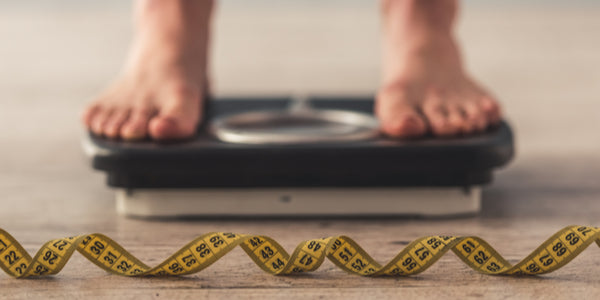
Prediabetes is a serious health condition in which blood sugars reach higher than normal levels. However, they are not high enough to be diagnosed as type 2 diabetes.
According to the Centers for Disease Control and Prevention (CDC), more than one in three, American adults have prediabetes. On top of this, 80 percent of those with prediabetes do not even know they have this condition.
Wondering if you or someone you love is at risk for prediabetes? Learn what prediabetes is, its symptoms, how to reverse it, and more.
What Is Prediabetes?
Also recognized as borderline diabetes, prediabetes is when blood sugars are considered higher than normal. This could be from the body getting desensitized to insulin and/or the body is not producing enough insulin.
Insulin is a fundamental hormone required for glucose utilization. It assists in glucose's entry into the cells following carbohydrate intake.
Clinically, prediabetes is identified based on a blood sugar level of:
• 100 to 125 milligrams per deciliter (mg/dL) following a fasting plasma glucose test
• 140 to 100 mg/dL after an oral glucose tolerance test
• 5.7 to 6.4 percent based on hemoglobin A1C
That said, prediabetes is essentially a wake-up call and opportunity to prevent the progression to type 2 diabetes. This is good news and means diabetes is not a final destination, as there are lifestyle changes one can make to successfully reverse prediabetes!
Risk Factors and Symptoms of Prediabetes
While it would be ideal, there may not be noticeable prediabetes symptoms and signs.
Luckily, the following early indicators and risk factors may shine a glimpse of light and guide you towards prevention.
Genetics
"It runs in the family" truly is a worthy defense. And while genetics should not be used as an excuse, a family history can raise the risk for prediabetes. Specifically, if parents or siblings have type 2 diabetes, that is considered a risk factor for prediabetes.
Certain races and ethnicities also increase its likelihood, including African-American, Hispanic, American Indian, Asian-American, and Pacific Islander.
Age
Like genetics, aging is an unmodifiable risk factor and should be recognized and anticipated. Diabetes risk is suggested to rise especially after age 45.
Overweight and Obesity
Having excess weight is a serious risk factor, if not the largest, of progressing to diabetes and other health conditions. Being overweight or obese is classified as having a body mass index (BMI) greater than or equal to 25 or 30, respectively.
Certain Medical Conditions
People with certain medical conditions, including gestational diabetes and polycystic ovary syndrome (PCOS), are at greater risk of developing prediabetes.
Sedentary Lifestyle:
Leading a sedentary lifestyle, or being physically active less than 3 times weekly, raises the risk of prediabetes.
Energy Loss
When sugar continues to circulate in the blood rather than be taken up by the cells, they are essentially deprived of functional energy.
Interestingly, energy loss may occur related to poor sleeping patterns and a strong link between inadequate sleep and diabetes risk exists. Therefore, inadequate sleep and/or low energy may be signs of prediabetes, although other conditions could also contribute to these.
Increased Urination and Thirst
Simply put, the body increases urine production when glucose remains in the blood rather than taken up by cells. Frequent urination ultimately leads to fluid loss and dehydration, and further cycling increased thirst.
These signs could be indicators of full-on diabetes or more mild symptoms could indicate prediabetes. A blood test and consulting with your doctor can further clarify these symptoms.
Darkened Skin
Although mostly recognized in individuals with diabetes, a condition known as acanthosis nigricans may start to surface with prediabetes. Acanthosis nigricans display dark, velvety skin, mostly patched on the groin, neck, and armpits.
If you are unsure of your risk for prediabetes, take the prediabetes risk test from the CDC and talk with your doctor about your results.
7 Ways to Help Reverse Prediabetes
Without taking charge and making lifestyle modifications, prediabetes can develop into type 2 diabetes within a five-year span. With 80 percent of those with prediabetes not even knowing they have this condition, it is important all adults follow lifestyle habits that can help reduce the risk of or reverse prediabetes.
1. Manage Weight
Weight loss and maintenance are extremely valuable, if not the greatest, influences to reduce the progression of prediabetes. Even a weight loss of five to seven percent of total weight (10-14 pounds for someone weighing 200 pounds) can reverse prediabetes risk.
As a bonus, successful weight loss can also lessen the likelihood of heart disease, stroke, and kidney failure.
2. Embrace Whole, Nutrient-Dense Foods
Skip out on prepackaged, convenience foods and focus most attention on their whole, natural form, including these foods that will not spike blood sugar.
Ultimately, a nutritious prediabetes diet is balanced with whole grains, fresh fruits and veggies, lean and plant-based proteins, dairy products, and healthy fat sources.
Trusting in BistroMD’s meal delivery service can also help ensure nutritional needs are being met, all while offering support the entire way! You can customize meal plans that are geared toward your health goals for weight loss, lowering prediabetes risk, and more.
3. Moderate Sugar Consumption
In prediabetes, sugar begins to build up in the bloodstream primarily related to insufficient insulin use. Although sugar (or glucose) comes from all carbohydrate sources, consuming excess in the form of sweetened beverages, candy, packaged sweets, etc. may further cause blood sugar to climb.
Reducing sweetened beverages is an important prediabetes lifestyle change. According to research from Tufts University, those who consume a sweetened beverage more than 3 servings a day, or an average of 6 servings a week, have a 46% higher risk of developing prediabetes.
According to the American Heart Association (AHA), men and women should not exceed more than nine (36 grams) and six teaspoons (25 grams) each day, respectively. Astonishingly, a 12-ounce soda contains an average amount of 30 to 40 grams of sugar!
4. Exercise Regularly
Consistent and regular exercise plays a large role in weight maintenance. It also further assists in more effective blood glucose uptake.
Interestingly, too, a 2016 study published in Diabetologia implies consistent moderate-intensity exercise is effective in improving blood sugar measures even without significant weight loss.
The AHA recommends individuals should partake in moderate-to-vigorous aerobic activity at 150 minutes weekly, which may include brisk walking, jogging, biking, swimming, and dancing. In addition, incorporate strength training at least two to three times weekly, focusing focus on the major muscle groups such as the back, chest, arms, and legs.
5. Ensure Quality and Adequate Sleep
Catch those Zzzs to help reverse prediabetes risk! Sleep deprivation affects the body in adverse ways, mostly disrupting hormone balance and the ability to efficiently metabolize glucose.
People who are sleep deprived have a higher risk for weight gain and even type 2 diabetes. Interestingly, even healthy individuals have displayed glucose intolerance - the ability to effectively breakdown glucose for proper energy use - following poor sleep patterns.
The National Sleep Foundation recommends the average adult should obtain seven to nine hours of quality sleep each night. So turn off electronics and lights and sleep towards lower blood glucose levels.
6. Check in with Your Doctor Regularly
Keep up with regular check-ups especially if you have risk factors for prediabetes. Staying proactive helps surface potential health risks while health care professionals can recommend specific preventative measures.
Knowing your health status can stimulate accountability and motivation to keep your body running as optimally as possible.
7. Commit to a Healthy Lifestyle
Commit to the complete lifestyle track. Reversing prediabetes is not a quick sprint, but a lifelong marathon with hurdles. How long it takes to reverse prediabetes can vary, but it requires a long-term commitment to a lifestyle instead of being viewed as a quick fix.
If you may ever trip and fall, dust off your hands and stand back up! Because in both the short and long run, your body's health will feel as if it crossed the finish line.
Prediabetes Risk Recap
While not full-on diabetes, prediabetes is a precursor for this disease with mildly high blood sugar levels. Unfortunately, many with prediabetes do not know they have it, and prediabetes can lead to type 2 diabetes if untreated.
Thus, it is important to be aware of signs, risk factors, and ways to reverse or prevent prediabetes. Following a healthy lifestyle which includes regular exercise, following a balanced diet based on whole foods, getting adequate sleep, weight regulation, and routinely checking in with your doctor are the most important steps for deterring this condition.
References:
Added sugars. American Heart Association. Published November 2, 2021. https://www.heart.org/en/healthy-living/healthy-eating/eat-smart/sugar/added-sugars.
American Heart Association recommendations for physical activity in adults and kids. American Heart Association. Published August 4, 2021. https://www.heart.org/en/healthy-living/fitness/fitness-basics/aha-recs-for-physical-activity-in-adults.
Caffrey M. Tufts study absolves diet soda in prediabetes, but sugary beverages are linked. AJMC. Published July 30, 2020. https://www.ajmc.com/view/tufts-study-absolves-diet-soda-in-prediabetes-but-sugary-beverages-are-linked.
Prediabetes - your chance to prevent type 2 diabetes. Centers for Disease Control and Prevention. Published December 21, 2021. https://www.cdc.gov/diabetes/basics/prediabetes.html.
Slentz CA, Bateman LA, Willis LH, et al. Effects of exercise training alone vs a combined exercise and nutritional lifestyle intervention on glucose homeostasis in prediabetic individuals: a randomised controlled trial. Diabetologia. 2016;59(10):2088-2098. doi:10.1007/s00125-016-4051-z







